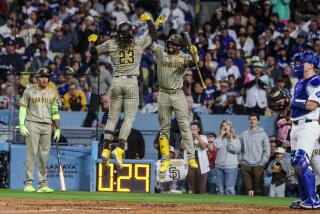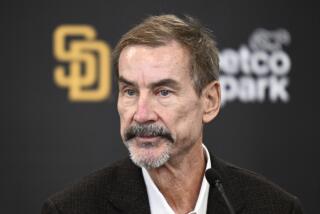Kennedy Is Traded by Padres : San Diego Gets Storm Davis From the Orioles
SAN DIEGO — Thanks to LaMarr Hoyt, the San Diego Padres on Thursday traded catcher Terry Kennedy and a minor league pitcher to the Baltimore Orioles for pitcher Storm Davis.
For two weeks, Jack McKeon, the Padre general manager, had been trying to complete a three-way deal: Kennedy to the Orioles for Davis, then Davis to the Philadelphia Phillies for outfielder Gary Redus and pitcher Charles Hudson. The Phillies hemmed and hawed and wanted to wait.
But when Hoyt, one of the Padres’ starting pitchers, was arrested on suspicion of smuggling illegal pills Tuesday night--leaving his baseball future in doubt--McKeon figured he’d better make the deal for Davis, 24, a power pitcher who was 9-12 with a 3.62 earned-run average in 1986. McKeon had to add minor league pitcher Mark Williamson, 27, who was 10-3 with a 3.63 ERA and 16 saves for Triple-A Las Vegas last year, to complete the deal.
Davis may never make it to San Diego. He could still end up in Philadelphia, according to McKeon, or he could replace Hoyt as trade bait as the Padres continue their search for a new third baseman.
The Padres are interested in Oakland’s Carney Lansford, Cleveland’s Brook Jacoby, Cincinnati’s Nick Esasky and Montreal’s Tim Wallach.
“I know Mr. McKeon has the reputation (of trading),” Davis said Thursday. “I think he’s called Trader Jack, or something like that. I understand that, and I guess our plans still will be to be in San Diego next year. If something comes up between now and then--and I hope it doesn’t--we’ll deal with it then.”
Kennedy, 30, had begged to be traded. Last season, then-Manager Steve Boros went to Kennedy one day to say that Triple-A catcher Benito Santiago would probably be the opening-day starter in 1987. Soon after, Kennedy took down the nameplate above his locker and said: “Won’t need this next year.”
Kennedy batted .264 with 12 home runs and 57 runs batted in last season, his sixth year in San Diego. That was much better than Oriole catchers, who batted a composite .200 last year. Their starter, Rick Dempsey, hit .139 with runners in scoring position. He was released after the season and Baltimore became interested in trading for Pittsburgh’s catcher, Tony Pena.
But Syd Thrift, the Pirate general manager, drove a hard deal and the Orioles turned to San Diego.
“I don’t think it’s a gamble when you get an established major league catcher who’s 30 years old,” said Hank Peters, Oriole general manager. “I didn’t want to give up on Storm, but another way to look at it is that he won just 19 games in two years, and you don’t win a division with that kind of performance.”
Kennedy had been on edge the last few days. When the Padres called a press conference on Tuesday--to announce the hiring of Larry Bowa as manager--Kennedy called the Padre offices, wondering if they were going to announce a trade.
“I’ve been waiting for word (of a trade) for 18 months,” he said Thursday. “I’m glad it’s over.”
He assumes he’ll start in Baltimore.
“I would think so,” he said. “No one’s said the word to me, ‘You’ll play every day.’ But I suppose I would be the catcher there, that they wouldn’t make a trade and give up a player like Storm Davis for me to be a backup or platoon player. But I can only suppose that way.”
He also said he is not parting with bitterness, even though the Padres seemed to give up on him last year. At times, Kennedy thought the organization resented him for being the player representative and speaking out during the 1985 strike negotiations. If anything, there were teammates who disliked his moodiness and his tendency to be a “clubhouse lawyer.”
At times last year he did appear bitter, but said Thursday that “a lot of the emotions that happen in the heat of the battle seem to be smoothed over now that the deal has already been made and you’re really not part of the organization that you felt--at times--mad at. . . . I’m not trying to dwell on that anymore.”
McKeon says Kennedy was expendable because he has young catchers Santiago and Sandy Alomar Jr. coming up and because Kennedy’s contract rises to $900,000 in 1987 and $1 million in 1988 (which is an option year).
As for Davis, he became a full-time player in the Oriole organization in 1983, touted as the next Jim Palmer. His fastball always was in the low 90-m.p.h. range but he never had a solid second pitch. He throws a hard slider, a knuckle-curveball and a split-fingered fastball but isn’t consistent with any of them. His best year was 1984, when he was 14-9 with a 3.12 ERA. Hip and ankle injuries slowed him in 1986.
And he wasn’t the most adored player in Baltimore, either. Warming up in the bullpen one day this year, he asked Dempsey: “You guys don’t have any faith in me, do you?”
“No, we don’t,” Dempsey said.
“What can I do to change it?” he asked.
“Finish a couple games,” Dempsey said.
More to Read
Go beyond the scoreboard
Get the latest on L.A.'s teams in the daily Sports Report newsletter.
You may occasionally receive promotional content from the Los Angeles Times.










